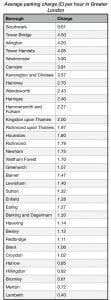14 years ago London introduced parking reform, impacting the allocation of spaces to tenants of new buildings. Rather than imposing a minimum number of required spaces, as handled before 2004, buildings were set with a maximum amount. Following 2001’s Planning Policy Guidance 13-Transport, issued by the central government, this shift in distribution was meant to reduce total car journeys – creating a cultural shift towards alternative transportation methods. It is worth noting that this phenomenon was not limited to London. Maximum parking standards were imposed across the UK.
Although the reform called for policy updates every 10-15 years, no discussions regarding the impact of modern traffic policies were found. Some examples of recent initiatives, particularly in London, include new speed limits in the Congestion Charge zone, Vision Zero, and the Central London Ultra Low Emission Zone. These Transport for London programmes appear to fall in line with London’s desire to greatly reduce car traffic. With more restrictions, it only makes sense for demand to decrease. A lot changed since the 2004 reform, which could explain why parking policies are no longer a priority.
Another factor potentially eliminating the need for an updated policy is how the sharing economy finds new opportunities. This collective model of temporarily renting out unused items or spaces, was not top of mind in 2004. While many applications like JustPark, Parkopedia, Parklet, Parkonmydrive, Stashbee, and Yourparkingspace help car owners find spaces rented out by individuals, a huge disparity between available parking and cost remains in most UK cities. This price discrepancy is especially found at car parks and municipal parking spaces, where most drivers are inclined to look. To help navigate parking in the Greater London area, we compiled a chart, found below. For maximum savings, we highly suggest checking out the applications mentioned. If you are interested in the reform’s history and impact, we invite you to read on.
Most expensive parking in London
We compiled a list of the average rate per hour in each Greater London borough. As you can see, the range is quite wide (depending on where you need to park). Hopefully this chart helps you plan ahead for your next trip.

Initial results of the parking maximum
In a study titled, “From Minimum to Maximum: Impact of the London Parking Reform on Residential Parking Supply from 2004 to 2010,” 22 of London’s 33 boroughs were surveyed, and it was concluded that a 40% reduction occurred between 2004-2010. This decrease is a direct result of eliminating the minimum standard. In total, 137,682 residential spaces were removed from London. A similar report titled, “Do Parking Standards Matter? Evaluating the London Parking reform with a Matched-Pair Approach,” discovered a drop from 1.05 to 0.19 average spaces (per unit) in London after the reform. Although it is true such restrictions can positively improve a city’s air quality, they also create increased competition for spaces.
Under utilisation of spaces
According to “Spaced Out Perspectives on parking policy,” there were 6.8 million spaces in Greater London in 1999. Of that number, 3.8 million were off-street. Most strikingly, there was a 43% decrease in on-street non-controlled (free parking) in London’s Inner Ring road area from 1999-2004. It is also worth noting that this is when the reform occurred. Following the maximum restriction, in 2005, there were 903,000 total available on-street residential spaces in Inner London. Interestingly, when comparing this number with the average cars in use from 2005-2008 (705,000), it seems a lot of under utilised spaces exist. Even though Greater London experienced a 12% increase in car ownership from 1997-2015, ample parking still exists. This information suggests that, with more people switching to alternative transportation methods, there is room for improvement regarding space discovery.
Increased fines for diesel car owners
With tougher restrictions placed on high-emissions vehicles, like diesel cars, driving through Central London, there are potentially more unused spaces. One example of a recent diesel deterrent is the Westminster’s City Council decision to increase the hourly charge for pre-2015 diesel cars to as much as £7.35 in the West End. Mirroring London’s current traffic policies, the goal is to reduce diesel cars passing through Westminster by as much as 270,000 per year. This rate increase, combined with the Central London Ultra Low Emission Zone, and zero-emissions experiment on Moor Lane, makes it extremely difficult for diesel car owners to both drive and park in London.
Conclusion
Although restrictions imposed by the 2004 reform greatly reduced the number of spaces available in major UK cities, like London, changes in behaviour and new policies deterring drivers have reduced overall parking demand. With the highest average municipal parking set at £9.61/hour in Southwark, and many carparks charging more, better means of pointing drivers to cheaper available spaces is necessary. While many sharing economy based applications are filling this gap, they require more preparation, context, and knowledge to use than simply turning up at an available municipal space or carpark. If policy reform is to occur in the future, it should acknowledge the advantage technology provides for drivers to better regulate rates.
Reports sourced
Guo, Zhan, and Shuai Ren. “From Minimum to Maximum: Impact of the London Parking Reform on Residential Parking Supply from 2004 to 2010?” Urban Studies 50, no. 6 (2012): 1183-200. doi:10.1177/0042098012460735.
Li, Fei, and Zhan Guo. “Do Parking Standards Matter? Evaluating the London Parking Reform with a Matched-pair Approach.” Transportation Research Part A: Policy and Practice 67 (2014): 352-65. doi:10.1016/j.tra.2014.08.001.